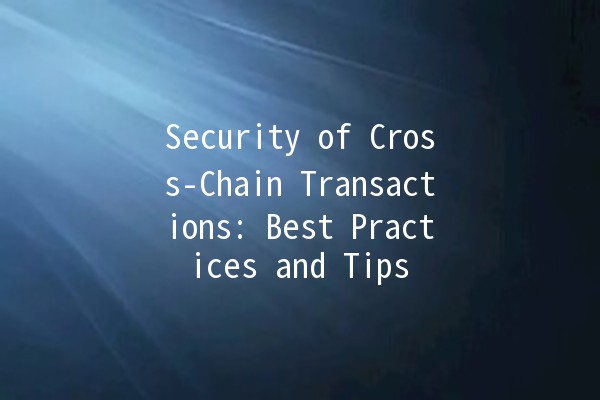
Understanding CrossChain Transactions
As blockchain technology matures, the necessity for interoperability among different blockchain networks has emerged. Crosschain transactions, which facilitate the transfer of assets and data across various blockchain ecosystems, promise enhanced flexibility and efficiency for users and developers alike. However, with great potential comes significant security risks.

Crosschain platforms allow users to engage in transactions across distinct blockchain networks, which can enhance liquidity and utility. Nevertheless, these transactions often involve numerous complexities and potential vulnerabilities that hackers can exploit. To navigate these challenges, it's crucial to understand the security dimensions of crosschain transactions. This article delves into effective strategies to ensure safe and secure crosschain transactions.
The Challenges of CrossChain Security
Before diving into best practices, it's essential to grasp the inherent risks tied to crosschain transactions:
To mitigate these risks, implementing robust security practices is imperative. Here, we detail five effective techniques to enhance the security of crosschain transactions.
Overview
Smart contracts serve as the backbone of crosschain transactions, enabling automated execution based on predefined conditions. However, poorly written contracts can result in substantial financial losses.
Application Example
When deploying a smart contract on a crosschain platform, ensure a professional audit is conducted by a reputable security firm. For instance, protocols like OpenZeppelin and ConsenSys provide comprehensive auditing services that can identify code vulnerabilities before deployment.
Tip for Implementation: Regularly update and audit your smart contracts even after deployment, as new vulnerabilities may emerge over time.
Overview
Oracles act as intermediaries that provide smart contracts with external data. They are essential in validating transactions across different chains but can represent a critical vulnerability if not used correctly.
Application Example
To mitigate risks, utilize decentralized oracles like Chainlink. Unlike centralized oracles, decentralized versions rely on multiple independent data sources, lessening the chance of a single point of failure or manipulation.
Tip for Implementation: When selecting oracles, prioritize those with a strong reputation in the blockchain community and proven security track record.
Overview
Using multisignature wallets adds an extra layer of security by requiring multiple signatures to authorize a transaction. This approach limits the risk associated with a single compromised private key.
Application Example
For teambased projects or large transactions, set up a multisignature wallet that requires signatures from a predefined number of individuals before executing any crosschain transaction. Platforms like Gnosis Safe can facilitate the creation and management of these wallets.
Tip for Implementation: Regularly review and update the list of signatories to include only trusted individuals and maintain a secure workflow.
Overview
Performing a risk assessment helps identify potential vulnerabilities in your crosschain transaction strategy. This process should encompass all components involved, including smart contracts, user interfaces, and intermediaries.
Application Example
Utilize a structured risk assessment framework, listing all potential threats such as code vulnerabilities, operational flaws, and external attack vectors. Assessing their likelihood and impact can guide prioritization for remediation.
Tip for Implementation: Conduct these assessments periodically and after any significant updates or changes to your system architecture.
Overview
User education plays a vital role in security, as many breaches result from human error rather than technical flaws. Ensuring users understand how to protect their assets can significantly bolster your overall security posture.
Application Example
Develop training materials focused on safe practices for crosschain transactions, including not sharing private keys, recognizing phishing attempts, and verifying transaction details before approval. Hosting regular webinars or workshops can facilitate ongoing education.
Tip for Implementation: Incorporate reallife case studies of security breaches to enhance understanding and awareness of potential risks.
Frequently Asked Questions
Crosschain transactions enable users to transfer assets between different blockchain networks through systems that support interoperability. This typically involves wrapping tokens in a native blockchain and issuing equivalent tokens in another blockchain.
The primary security concerns include vulnerabilities in smart contracts, poor standardization between blockchains, increased attack surfaces due to multiple protocols, and reliance on oracles, which could be manipulated.
Engaging a reputable third party with experience in blockchain development is crucial for smart contract audits. They will review the code for vulnerabilities, recommend best practices, and help ensure the contract operates securely before deployment.
Oracles bridge the gap between blockchains and the external world by providing verified data (like market prices) to smart contracts. In crosschain scenarios, they are vital for ensuring accurate information transfer across various platforms.
Multisignature wallets require multiple private keys to authorize a transaction, enhancing security by reducing reliance on a single user. This is particularly beneficial for organizations or projects that handle substantial assets, requiring collaborative decisionmaking.
Absolutely! Many security breaches occur due to user errors such as falling for phishing scams or mishandling private keys. Educating users about safe practices can significantly lower the risk associated with crosschain transactions.
The security of crosschain transactions is critical in ensuring the safe and seamless transfer of assets across networks. By adopting these best practices and remaining informed about emerging threats and techniques, users and developers can proactively protect themselves and bolster the integrity of crosschain platforms.

